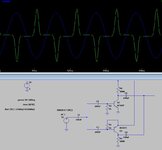neazoi
Advanced Member level 6
I have designed this class-C amplifier which works on both input sinewave peaks.
As expected, this waveform is produced only when the input sine peaks are at about 0.7v.
Is there any way I can make this (or another class-C) amplifier working in the uV levels?
As expected, this waveform is produced only when the input sine peaks are at about 0.7v.
Is there any way I can make this (or another class-C) amplifier working in the uV levels?
